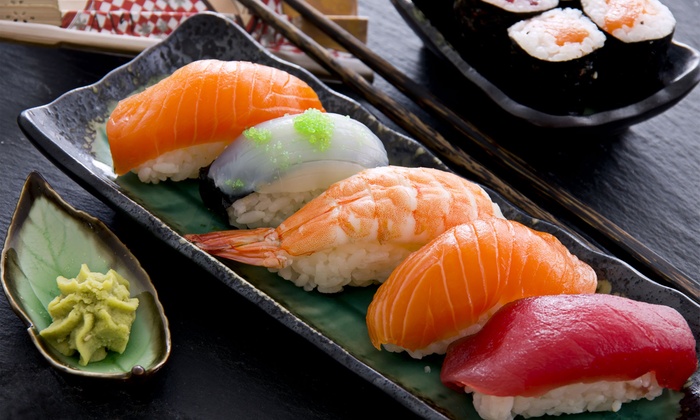The Art of Sushi
Whether you’re trying sushi for the first time or a huge fan, here’s some fun sushi facts to broaden your knowledge.Sushi comes in many different shapes and forms, and it encompasses everything from quick and cheap plates served up on a conveyor belt, to elaborate Michelin-starred dining experiences. Sushi beloved everywhere from its birthplace of Japan, to the US, Europe, and South Africa and beyond, making sushi a truly global cuisine.
Sushi Types
Makizushi, also known as “norimaki,” refers to a type of sushi where rice and ingredients are carefully rolled in a sheet of nori seaweed, which is then cut into smaller pieces. It’s believed that makizushi came into existence in the early 1700s, soon after sheet nori was invented with a similar technique used for papermaking. The name norimaki is made up of two Japanese words: “Maki” meaning to roll and “nori” referring to the toasted sheet of nori seaweed used to wrap the ingredients.
Temaki is a novel type of sushi with a shape resembling that of an ice cream cone. To make it, rice and ingredients are held within a sheet of nori wrapped into a conical shape. It’s popular at restaurants, as well as for making at home, given its simplicity. Temaki lends itself to a variety of fillings, with some popular types including umeshiso—a paste made of fresh shiso leaf and umeboshi (pickled plum), negitoro, squid with and without natto, and sweetened omelet.
Japan’s narezushi—a dish of fish preserved for several months to several years in salt and rice—is a perfect example of this technique that dates to the Nara period (710–794). Narezushi is commonly regarded as the original form of sushi, even though the rice was originally discarded before eating. Over time, the fermentation period became shorter so that the rice could be eaten with the fish, which then gave way to more modern types of sushi. These days, narezushi is generally less popular because of its extremely pungent flavor. However, funazushi of the Shiga prefecture remains popular, which is made using the nigorobuna fish from nearby Lake Biwa. Because it takes up to five years to ferment, funazushi is considered a regional delicacy due to its high price.
Nigiri is the original form of sushi that we know today. Also called edo-mae (meaning “in front of Edo”), the name refers to its birthplace of Tokyo (formerly Edo). It’s made up of a hand-pressed rice cylinder (shari) topped with any number of ingredients (neta). It’s believed to have been invented as a type of “fast food” by an enterprising sushi chef working in the Edo area during the 1800s who decided to sell his freshly created sushi to nearby workers for a quick snack. The topping can be seafood, vegetables, meat, omelet, or tofu, and in addition to fresh seafood, the fish may be pickled in soy sauce or vinegar, or broiled with a blowtorch. A simple coating of marinade and garnishes such as spring onions, shaved onion, or chives may also be added.
Temari is a less known variety of sushi overseas and is also not as common to find in Japan, although it’s a popular style of sushi to make at home given its simplicity in form. It’s made with a small round ball of pressed rice topped with a thin layer of fish or other ingredients, which is fitting since the name comes from the traditional Japanese embroidered ball, temari, meaning “hand ball.” Often colorful and decorative, it’s a popular food for parties and picnics and is often made for the traditional girl’s day celebration known as Hinamatsuri. If making temari for a picnic, it’s best to used cured or cooked seafood rather than raw sashimi.
Inari-zushi is quite different from the other varieties mentioned above since in its most common form it doesn't contain any fish and is quite sweet in flavor. Inari is a pouch-like piece of aburaage(deep-fried tofu) that has been simmered in a seasoning of mirin, soy sauce, dashi, and sugar. It’s named after the Shinto god, Inari, who is said to have had a fondness for tofu. The seasoned inari pouch is most commonly filled with vinegared sushi rice to create a sweet, slightly sour, juicy dish. However, inari-zushi can also be filled with rice mixed with other ingredients, or rice topped with a range of ingredients like mushrooms, squid, boiled prawns, chives or shredded omelet. The versatility, ease of making, and portability of inari-zushi make it a popular item for bento as well as finger food for picnics and parties.
How to eat sushi correctly?
Don’t Mix Perfume and Sushi. Those who truly know how to eat sushi understand that the experience has as much to do with the smell as it does taste. Sushi’s basic freshness should never be overwhelmed by needless flavoring or smells—the aroma of the fish itself and the scents around it are actually crucial to enjoying it. Therefore, sushi etiquette demands that you not wear any perfume, cologne or scented body lotion as the fragrance might interfere with the flavor of the sushi.
Eat in the “Correct” Order
Of all the possible rules about how to eat sushi, one of the most surprising might be that there is a specific order for eating sushi. While nothing is written in stone, some people say that it’s better to start with whitefish and lighter tasting fish followed by richer, more oily items such as toro (fatty tuna) and grilled eel. In any case, you’ll want to cleanse your palate between each type of sushi with a bit of pickled ginger and a sip of green tea.
Use Soy Sauce Sparingly
Sushi is best when energized by just the right amount of soy sauce and wasabi. At nicer restaurants, the chef will typically apply soy sauce for you to create the perfect balance for each piece, so you shouldn’t have to add any more. However, if the chef doesn’t add it for you, then when dipping your sushi in soy sauce make sure to dip the fish side and not the rice side.
Dip Your Sushi Fish-side Dow
Dipping your sushi fish-side down is mainly to prevent the rice from falling apart, but it also just tastes better—compare soy-soaked rice with the clean variety and you’ll agree!
When picking up nigiri sushi (your standard rice-with-a-piece-of-fish-on-top sushi) with chopsticks, you’ll want to first tip the piece onto its side then grasp it with one chopstick against the piece of fish itself (the neta) and one chopstick against the rice part (the shari). This is to prevent the neta and the shari from separating, which can happen if you try to pick up the sushi rice-side down. It also prevents the shari from being soaked in soy sauce, which as we already mentioned is a big no-no. You should also mind your sushi manners by refraining from breaking individual pieces into smaller parts. Proper sushi etiquette dictates that you eat the nigiri sushi in one bite.
How to make sushi at home? Sushi Recipe
Ingredients
2 cups sushi or short grain rice
2 cups water, plus extra for rinsing rice
2 tablespoons rice vinegar
2 tablespoons sugar
1 tablespoon kosher salt
- Place the rice into a mixing bowl and cover with cool water. Swirl the rice in the water, pour off and repeat 2 to 3 times or until the water is clear.
- Place the rice and 2 cups of water into a medium saucepan and place over high heat. Bring to a boil, uncovered. Once it begins to boil, reduce the heat to the lowest setting and cover. Cook for 15 minutes. Remove from the heat and let stand, covered, for 10 minutes.
- Combine the rice vinegar, sugar and salt in a small bowl and heat in the microwave on high for 30 to 45 seconds. Transfer the rice into a large wooden or glass mixing bowl and add the vinegar mixture. Fold thoroughly to combine and coat each grain of rice with the mixture. Allow cooling to room temperature before using to make sushi or sashimi.
References:
https://gurunavi.com/en/japanfoodie/2017/05/types-of-sushi.html?__ngt__=TT0eee8cd69008ac1e4aed6f93ASwUPEHKiouMIEr0LC2p
https://gurunavi.com/en/japanfoodie/2015/10/sushi-etiquette-tips.html?__ngt__=TT0eee8ec49002ac1e4ae20583P9l1aWsCUHbWUVpTXbvo
Search
Categories
Popular Posts



















Comments: 0
No comments